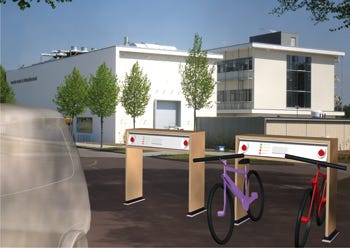As new and upcoming international standards look at the charging electronics, connector types, and communications on the insides of electric vehicle charging stations, charger manufacturers are turning towards plastics as they take different approaches to developing covers for the outside.
November 2, 2011
As new and upcoming international standards look at the charging electronics, connector types, and communications on the insides of electric vehicle charging stations, charger manufacturers are turning towards plastics as they take different approaches to developing covers for the outside.
Fraunhofer WPC charging station rendering
Outdoors, charging stations must remain durable in northeastern Europe's icy winter weather as well as heat resistant in the southwest deserts of the United States. They also need to allow unhampered communications, as more are operating with wireless, Near Field Communication or Radio Frequency Identification communications from cell phones, key rings, or cards. Some charging stations now contain links to databases that will accept and keep track of payments.Electric vehicle charging stations are also offered for indoor use as part of private garages or carports, and in covered parking lots at commercial or other public places. Though they may not have the same weatherability requirements as those used outdoors, materials used for indoor covers must also feature the same lightweight, flame retardant, and electrically insulating properties.
As the demand grows, a number of manufacturers offer innovative uses of new plastics in this growing industry:
Germany's Fraunhofer Institute for Mechanics of Materials is developing and testing a new electric vehicle charger made from wood-plastic composites, the same recyclable material that is used for decking and patio furniture, to build modular chargers into outdoor furniture that could blend into existing architecture.
Dutch charging manufacturer EV-Box B. V. uses Bayblend FR 3000 made by Bayer MaterialScience as its EV charging station cover material. Serving Belgium, the Netherlands, and Germany, maps on the EV-Box website show charger locations that are already dense with units at this early stage of this growing industry. Installed in hotels, shopping malls, parking lots, as well as street-side, their pole and wall-mounted electric vehicle chargers are used in both indoor and outdoor private and commercial locations, and can power electric cars, bicycles, or scooters. The new plastic they use from Bayer MaterialScience is a recyclable halogen-free PC+ABS bend (polycarbonate/acrylonitrile-butadiene-styrene) that allows commercial mass manufacturing at lower unit costs compared to metal.
Coulomb Technologies' ChargePoint Charging Stations, installed at malls, parking lots, and soon at 800 new locations at Walgreen pharmacies in the United States, use other polycarbonate resins also supplied by Bayer MaterialScience. These transparent covers allow instructions and advertising messages to be displayed in multiple languages while also offering durable protection for the electronics inside.
There is still room for innovation in the electric charging space, as charging stations don't yet have a singular, iconic form. As designs mature to be state of the art, are mass produced, and become incorporated in more locations, plastics will continue to be a critical part of this rapidly growing industry.
About the Author: Debbie Sniderman writes for, owns, and consults with VI Ventures, an R&D and manufacturing consulting company for renewable energy products and technologies.
About the Author(s)
You May Also Like


